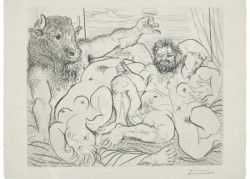Thank God for art dealers and collectors, if it wasn’t for them many great works of art would have been lost. This is the case for the mythical Picasso prints from The Vollard Suite. Commissioned by Ambroise Vollard, the greatest avant-garde Paris dealer and print publisher of his day, Picasso produced 100 etchings between 1930 and 1937 for an art book that was never accomplished because of Vollard’s death in a car accident in 1939. If this fatality wasn’t enough to prevent the greatness of one of the best series of works by Picasso, the outbreak of the Second World War had The Vollard Suite sat to rot, forgotten in a warehouse. Only to be saved, thankfully, by art dealer Henri Petiet. Now, for the first time in a British public institution, The British Museum exhibits its recently acquired complete set of the series for free until September 2nd. It is shown along with classical sculptures as the kind Picasso himself was inspired by, an advantage that The British Museum can allow its visitors.
As a result from an exchange the artist had done with Vollard for a Cézanne and a Renoir, the etchings illustrate a classical theme and also bear a homage to his great predecessors Goya and Rembrandt. Loose strokes mirror Picasso’s virtuosity, while Rembrandt was more contained, detailed and planned. All in a one chance only medium. There is no correcting in an etching. His representation of classical antiquity with no compromise and bearing a lightness that could only come from Picasso’s artistic freedom. He contemporaneously revisits classicism, for him the sculptures are still alive. He uses cubist style and a bit of surrealism, recognized from some of his paintings like his version for Velazquez Las Meninas or even Guernica, which he was painting at the same time as The Vollard Suite. The face of the screaming mother with the baby in her hands can be identified in Rape Beneath the Window.
Some of the etchings are very erotic, fruit of Picasso’s psyche, including the sculptor studio and the minotaur series. He saw himself as the minotaur in his relationship with Marie-Thérese Walter. This mythical creature represents the forces of uncontrolled emotion and behaviour. It is both a brutal presence and a tender lover. He appeared to be asking himself, does she love me even as a monster? He also uses the figure of a blind minotaur in Blind Minotaur Led by a Little Girl in the Night a pressage for Guernica as an affirmation of his political engagement with the Republicans during the Spanish Civil War. Marie Thérese was the little girl holding the white dove of peace. For me, a very significant statement about how power is the origin for monstrosities like war and how love is important in the search for peace. His painting are still affecting our world today, hopefully.



